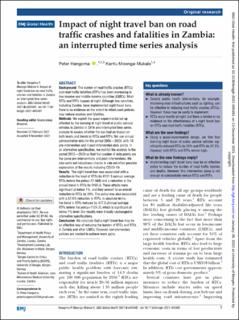| dc.contributor.author | Hangoma, Peter | |
| dc.contributor.author | Moonga-Mukale, Kantu | |
| dc.date.accessioned | 2022-02-21T14:37:42Z | |
| dc.date.available | 2022-02-21T14:37:42Z | |
| dc.date.created | 2022-01-20T22:49:31Z | |
| dc.date.issued | 2021 | |
| dc.identifier.issn | 2059-7908 | |
| dc.identifier.uri | https://hdl.handle.net/11250/2980607 | |
| dc.description.abstract | Background
The burden of road traffic crashes (RTCs) and road traffic fatalities (RTFs) has been increasing in low-income and middle-income countries (LMICs). Most RTCs and RTFs happen at night. Although few countries, including Zambia, have implemented night travel bans, there is no evidence on the extent to which such policies may reduce crashes and fatalities.
Methods
We exploit the quasi-experimental set up afforded by the banning of night travel of public service vehicles in Zambia in 2016 and interrupted time series analysis to assess whether the ban had an impact on both levels and trends in RTCs and RTFs. We use annual administrative data for the period 2006—2020, with 10 pre-intervention and 4 post-intervention data points. In an alternative specification, we restrict the analysis to the period 2012—2020 so that the number of data points are the same pre-interventions and post-interventions. We also carry out robustness checks to rule out other possible explanation of the results including COVID-19.
Results
The night travel ban was associated with a reduction in the level of RTCs by 4131.3 (annual average RTCs before the policy=17 668) and a reduction in the annual trend in RTCs by 2485.5. These effects were significant at below 1%, and they amount to an overall reduction in RTCs by 24%. The policy was also associated with a 57.5% reduction in RTFs. In absolute terms, the trend in RTFs reduced by 477.5 (Annual average RTFs before the policy=1124.7), which is significant at below 1% level. Our results were broadly unchanged in alternative specifications.
Conclusion
We conclude that a night travel ban may be an effective way of reducing the burden of RTCs and RTFs in Zambia and other LMICs. However, complementary policies are needed to achieve more gains. | en_US |
| dc.language.iso | eng | en_US |
| dc.publisher | BMJ Publishing Group | en_US |
| dc.rights | Navngivelse-Ikkekommersiell 4.0 Internasjonal | * |
| dc.rights.uri | http://creativecommons.org/licenses/by-nc/4.0/deed.no | * |
| dc.title | Impact of night travel ban on road traffic crashes and fatalities in Zambia: an interrupted time series analysis | en_US |
| dc.type | Journal article | en_US |
| dc.type | Peer reviewed | en_US |
| dc.description.version | publishedVersion | en_US |
| dc.rights.holder | Copyright Author(s) (or their employer(s)) 2021. | en_US |
| dc.source.articlenumber | e005481 | en_US |
| cristin.ispublished | true | |
| cristin.fulltext | original | |
| cristin.qualitycode | 1 | |
| dc.identifier.doi | 10.1136/bmjgh-2021-005481 | |
| dc.identifier.cristin | 1986986 | |
| dc.source.journal | BMJ Global Health | en_US |
| dc.identifier.citation | BMJ Global Health. 2021, 6 (12), e005481. | en_US |
| dc.source.volume | 6 | en_US |
| dc.source.issue | 12 | en_US |

